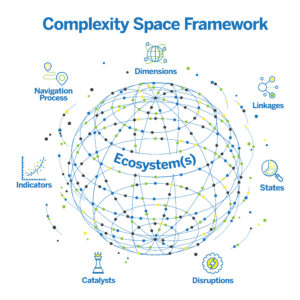The Complexity Space™ Framework (CSF) offers a transformative approach to understanding and influencing the complex dynamics that drive organizational ecosystems. It is more than a framework; it’s a mindset and a methodology that empowers leaders, managers, and teams to navigate the challenges of complexity and uncover innovative pathways for growth and change.
At its core, CSF equips organizations with language, distinctions, and tools to evaluate, test, and implement new possibilities for action. This approach fosters pattern awareness and catalyzes actionable insights, making it easier to address systemic issues, embrace uncertainty, and thrive in a constantly evolving environment.
A Dual Perspective: Red Lens vs. Blue Lens
The CSF provides clarity on the critical differences between:
- The Red Lens (linear thinking): Focused on predictable cause-and-effect relationships, efficiency, and static solutions.
- The Blue Lens (complexity thinking): Centered on dynamic, interconnected systems, emergent behaviors, and adaptive strategies.
By shifting to a Blue Lens perspective, organizations gain a deeper understanding of the hidden patterns shaping their ecosystems, enabling them to respond to challenges with agility and creativity.
The Seven Interdependent Elements of CSF
CSF is built around seven interdependent elements that collectively offer a holistic view of an organization’s ecosystem. These elements are the foundation for fostering pattern-centric awareness and enabling impactful conversations.
1. Ecosystem(s) – Patterns in Context
Every organization operates as an ecosystem of interconnected and interdependent elements. The CSF identifies patterns that emerge in specific contexts, revealing opportunities for strategic intervention and adaptation.
- Application: Map your organization’s ecosystem to identify hidden opportunities and challenges.
2. Dimensions – Ecosystem-Wide Patterns
Dimensions highlight overarching patterns that influence behavior and outcomes across the entire ecosystem. They provide insights into organizational culture, processes, and strategic alignment.
- Application: Use Dimensions to align strategy with ecosystem-wide dynamics.
3. Linkages – Connecting Patterns
Linkages focus on the relationships and interactions between elements, highlighting how changes in one area ripple through the ecosystem.
- Application: Strengthen collaboration and communication by addressing critical connection points.
4. States – Strategic Meta-Patterns
States represent high-level, strategic patterns that shape the organization’s direction and long-term goals.
- Application: Align leadership decisions with the organization’s evolving meta-patterns.
5. Disruptions – Disturbing Patterns
Disruptions are events or dynamics that disturb existing patterns, creating opportunities for transformation or risk.
- Application: Identify and leverage disruptions as catalysts for innovation.
6. Catalysts – Influencing Pattern-Based Change
Catalysts are forces or actions that spark and sustain change within the ecosystem. They are essential for driving innovation and adaptability.
- Application: Develop strategic initiatives that act as catalysts for meaningful transformation.
7. Indicators – Signs of Pattern Movements
Indicators are measurable signs that reveal shifts in patterns, providing critical feedback on the impact of actions and strategies.
- Application: Monitor indicators to assess progress and adapt strategies in real-time.

- Ecosystem(s)– Patterns in Context
- Dimensions -Ecosystem wide Patterns
- Linkages – Connecting Patterns
- States -Strategic “Meta” Patterns in Ecosystems
- Disruptions – Disturbing Patterns
- Catalysts – to Influence Pattern-Based Change
- Indicators – of Pattern Movements
- Navigation Process
The Navigation Process: Guiding Action Through Complexity
The Navigation Process integrates these seven elements into a structured yet flexible approach to:
- Diagnose ecosystem dynamics.
- Explore emergent opportunities.
- Design interventions for sustainable impact.
- Evaluate outcomes through iterative feedback loops.
Why Choose CSF?
- Actionable Insights: Transform abstract complexity into practical strategies.
- Organizational Agility: Adapt quickly to changing circumstances with confidence.
- Innovative Thinking: Foster a culture of exploration and experimentation.
